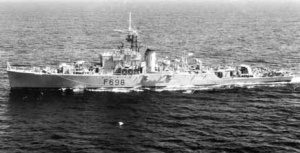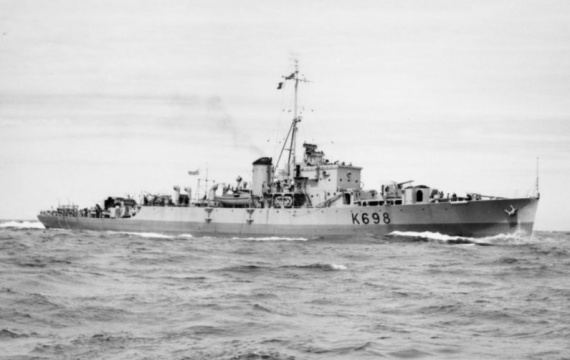HMAS Condamine
| Class |
River Class |
|---|---|
| Type |
Frigate |
| Pennant |
K698/F698 |
| Builder |
New South Wales State Dockyard, Newcastle |
| Laid Down |
30 October 1943 |
| Launched |
4 November 1944 |
| Launched by |
Mrs McKell, wife of the Premier of New South Wales |
| Commissioned |
22 February 1946 |
| Decommissioned |
2 December 1955 |
| Dimensions & Displacement | |
| Displacement |
|
| Length | 301 feet 7 inches (overall) |
| Beam | 36 feet 6 inches |
| Draught | 12 feet (mean) |
| Performance | |
| Speed | 19½ knots |
| Complement | |
| Crew | 175 |
| Propulsion | |
| Machinery | Triple expansion, 2 shafts |
| Horsepower | 5500 |
| Armament | |
| Guns |
|
| Other Armament |
|
| Awards | |
| Battle Honours | KOREA 1950-53 |

HMAS Condamine was ordered as part of Australia's shipbuilding program during the Second World War. Twelve of these Australian built frigates were to enter service with the Royal Australian Navy. A further ten were ordered but cancelled as the war drew to a close.
Eight, HMA Ships Barcoo, Barwon, Burdekin, Diamantina, Gascoyne, Hawkesbury, Lachlan and Macquarie, were built to the British River Class design and Australia likewise named its frigates after Australian rivers. A further four, HMA Ships Condamine, Culgoa, Murchison and Shoalhaven, were also named after Australian rivers but were built to the design of the Royal Navy's Bay Class Frigates. These latter ships were generally known as Modified River Class Frigates although they are sometimes referred to as Bay Class.
Condamine commissioned at Sydney on 22 February 1946 under the command of Lieutenant Commander Robert J Hodge RAN.
After a period working up in the waters off New South Wales waters, Condamine proceeded to New Guinea in May 1946, visiting Port Moresby, Wewak, Alexishafen, Finschhafen, Rabaul and the fleet base at Manus, before returning to Sydney at the end of July.
In October 1946 she proceeded to Darwin where she remained based until 13 December 1946. On this day she began the long voyage to Kangaroo Island, South Australia, towing an oil fuel lighter. This task was accomplished without mishap on 11 January 1947, when, after handing over the lighter to the tug HMAS Reserve in D'Estree Bay, Condamine proceeded to Melbourne where she remained in refit until early March 1947.
Between May and August 1947 and again from December 1947 to March 1948, Condamine saw further service as the Australian Squadron Representative in New Guinea waters.
Except for a brief visit to Manus in September 1948, the remainder of the year was spent in home waters. At the close of 1948 Condamine had steamed 63,000 miles.
Throughout 1949 Condamine remained in Sydney Harbour, commencing seagoing service again in January 1950 when she exercised with the Royal Navy submarine HMS Thorough. The remainder of the year was spent in eastern Australian waters, mainly on anti-submarine exercises with one of the Royal Navy submarines operating with the Australian fleet.
Condamine was continually in service in 1951, exercising with other units of the fleet and averaging about one thousand miles per month in eastern Australian waters.
In June 1952 Condamine departed Sydney to join the United Nations forces operating in Korean waters. She reached Singapore on 11 July and Japanese waters at the close of the month.
Condamine began operational duty in the Korean War in the Haeju area on the Korean west coast as a unit of Task Unit 95.12.4 on 4 August 1952. Three days later she fired her first shots of the war with a bombardment of enemy positions on the mainland opposite Mudo Island.
On 8 August Condamine relieved USS Kimberly as Commander Task Unit 95.12.1 in defence of the Sokto/Chodo area at the entrance to the River Chinnampo. The following week was spent on daily bombardment of the mainland, largely in co-operation with air elements of the west coast carrier group, Task Element 95.11. Condamine was relieved on 16 August by HMS St Brides Bay and after a typhoon delayed passage the frigate reached Sasebo on 19 August.
Condamine';s next assignment was on the east coast theatre and she was the first Australian frigate to operate in that area. On 22 August she reported for duty to Commander Task Element 95.22, Commander Chandler USN in USS McDermut, at Yongdo. There she relieved HMS Mounts Bay and with other ships of the Task Element began a period in defence of Yandgo, with coastal patrols north to Chongjin and south to Chado harassing enemy rail communications.
It was in the main a quiet period for Condamine with suitable targets scarce. Railway traffic proved elusive and apt to seek the safety of tunnels and cuttings. Even direct hits were no guarantee of ultimate destruction as Condamine discovered when after hitting a two engine train and forcing it to stop, it divided at the point of damage, half disappearing into a tunnel while the other half made haste for the shelter of a cutting.
Some compensation for Condamine's disappointed gunners came on 10 September when a highly successful bombardment near Tanchon ended with the complete destruction of six buildings previously untouched.
On 11 September HMS Charity relieved the Australian frigate. In the nineteen operational days on the east coast Condamine had steamed 2577 miles.
Ten days at Kure, 13 to 22 September, was followed by a return to the Haeju area on 23 September where she relieved St Brides Bay as Commander Task Unit 95.12.4. Other ships of the unit comprised South Korean Navy patrol craft.
A fortnight was spent in defence of the offshore islands of the area. Night stations were normally to the east of Taesuap Island from which position the mud flats between the mainland and Yongmae Do Island were effectively covered and the movement of enemy junks down the Haeju prevented. Day stations were normally in the vicinity of Taeyongpyong Do.
On 28 September the frigate gave support to a United Nations guerilla raid on the Chomi Do peninsula. Strong opposition eventually forced a withdrawal, with Condamine evacuating a wounded United States Major and a Marine Sergeant. On other days harassing fire served to relieve the monotony of what proved to be a mainly routine patrol.
On 7 October Condamine began the last phase of her third patrol in the Sokto/Chodo area and after six uneventful days, proceeded for Sasebo.
Her fourth patrol began with four days as Commander Task Unit 95.12.2 at Paengyong Do. Bad weather restricted both friend and enemy, reducing Condamine's task to routine watch over the offshore islands.
Six days at Haeju followed, with daily bombardment tasks. Ten rounds of 4-inch ammunition were fired on 26 October, twelve rounds the next day and eighty rounds north of Mudo on the 28th.
Two days at Sokto supporting the minesweepers brought a quiet month to a close. The patrol finally ended with the frigate operating at Haeju on 8 November. A return to Haeju on 28 November followed a week at Kure. Ten days on patrol were followed by a visit to Sasebo before returning to the Korean west coast on 23 December. Patrols off Paengyong Do and Haeju extended to 6 January 1953.
On 5 January 1953 Condamine engaged the enemy batteries opposite Mudo Island on the mainland. Her Commanding Officer commented "This shoot of sixty-six rounds was the best Condamine has done, and I was almost ready to believe the Korean spotters reports".
On 6 January the frigate left Haeju for escort duties before proceeding to Kure. Haeju and Sokto/Chodo patrols on the west coast continued to occupy Condamine until 15 March 1953, when she completed her final patrol, having steamed more than 22,000 miles in Korean waters.
Condamine returned to Sydney on 20 April 1953 for a refit before resuming duty as a unit of the fleet operating in eastern Australian waters.
Between April and July 1954 Condamine was based at Darwin, conducting surveillance of the Japanese Pearling Fleet operating in the waters to the north of Australia.
In February 1955 she returned to the Far East to begin a period of service in Japanese and Korean waters. On 14 November she returned to Sydney having steamed some 180,000 miles since commissioning in February 1946. Condamine paid off into Reserve on 2 December 1955.
Without being again brought into commission, Condamine was sold on 21 September 1961 to the Tolo Mining and Smelting Co Ltd of Hong Kong. Late in December 1961 the former Royal Australian Navy tug Reserve left Sydney for Hong Kong towing Condamine and her sister ship Burdekin. The other two vessels had been purchased by the same firm. All were ultimately released to the Mitsubishi Company of Japan to be broken up for scrap in Japan.
Further reading
'HMAS Condamine: The Story of a Uniquely Australian Frigate' by Lieutenant Vince Fazio RAN (Rtd), Petersham, NSW, 2002.






